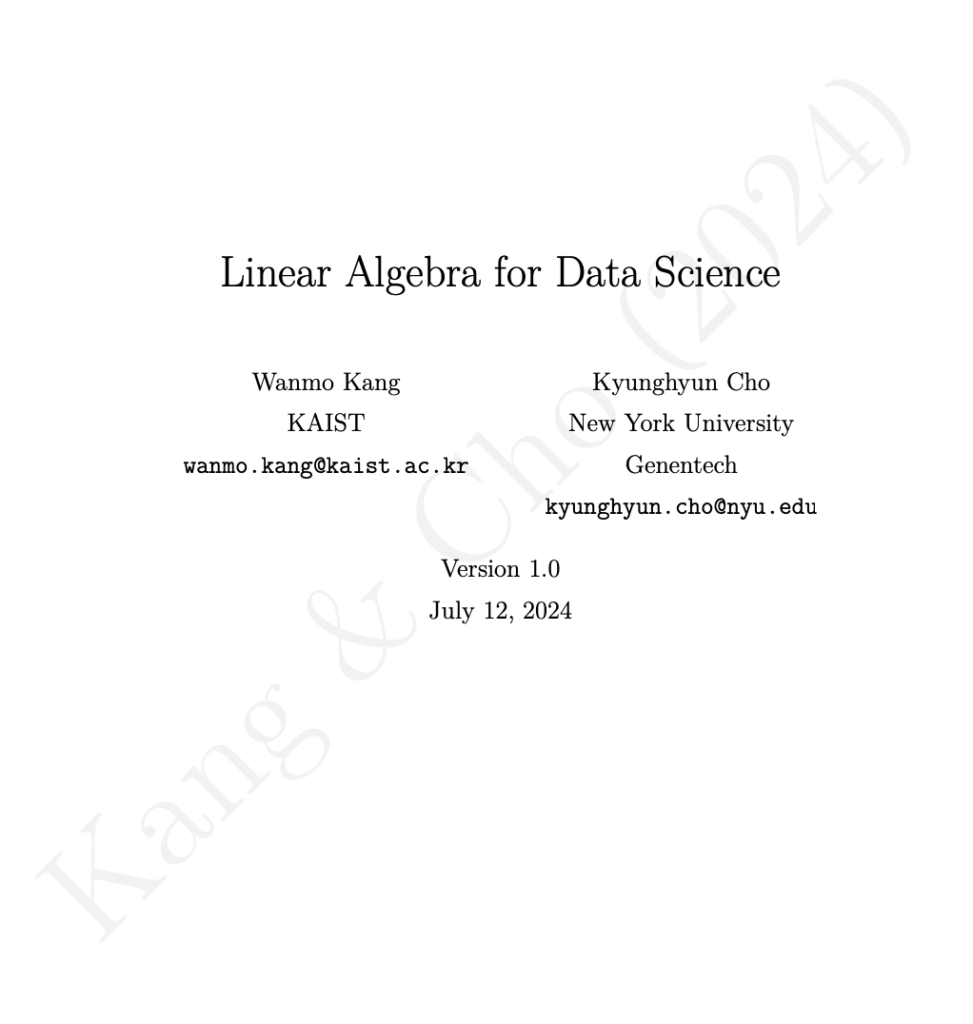We (Prof. Wanmo Kang and Prof. Kyunghyun Cho) have been discussing over the past few years how we should teach linear algebra to students in this new era of data science and artificial intelligence. Over these discussions, which also led to some research collaboration as well, we realized that (one of the central concepts from linear algebra that is used frequently in practice, if not every day, was) the central concepts from linear algebra invoked frequently in practice, if not every day, were projection, and consequently singular value decomposition (SVD) as well as even less frequently positive definiteness. Unfortunately, we noticed that existing courses on linear algebra often focus much more on the invertibility (or lack thereof), to the point that many concepts are introduced not in the order of their practicality nor usefulness but in the order of the conveniences in mathematical derivations/introductions. We began to wonder a lot whether we can introduce concepts and results in linear algebra in a radically different way.
So, here’s a new textbook on linear algebra, where we re-imagined how and in which order linear algebra could be taught. Click the cover page below, or https://drive.google.com/file/d/1pLrhXT_wBeQNJegbkVbC2fll9z_ykXzD/view?usp=drive_link (last updated on September 26 2025), to download the full textbook. We also provide a version where we mix Korean and English, in order to help students who are more familiar with Korean follow the textbook more easily, at https://drive.google.com/file/d/1Qj8fnRZhgpcAHF2FTUhKTQQ0vZAFmrbv/view?usp=sharing (outdated).

More specifically, we have ensured that useful and practical materials are not pushed aside toward the end of the book rather that they are treated as early as possible, without compromising on mathematical rigour, so that students can become proficient in various useful results and algorithms from linear algebra even after reading the first few chapters of this textbook. To give you a sense of what we mean by this, here’s a high-level table of contents of the book:
- Introduction
- Matrices and Gaussian Elimination
- Vector Spaces
- Orthogonality and Projections
- Singular Value Decomposition
- SVD in Practice
- Positive Definite Matrices
- Determinants
- Further Results on Eigenvalues and Eigenvectors
- Advanced Results in Linear Algebra
- Big Theorems in Linear Algebra
As you may see in the table of contents, the singular value decomposition (Chapter 5) is placed earlier than the determinant (Chapter 8) and the eigendecomposition (Chapter 9), which is a reversed order of topics from the usual linear algebra books. This change is possible since we adopt an optimization/variational approach to solve the problems formulating the projection and the singular value decomposition. Many questions invoking results of linear algebra in their solution procedures are in the shape of optimization by nature. Therefore, each step of our variational approach can be interpreted in the perspective of the original question, which results in a better understanding of many useful concepts than the usual algebraic derivation of the same concepts. The authors believe that the linear algebraic tools obtained through this problem-driven setting will be always ready for real-world questions.
We also added several chapters in Appendix to cover concepts and results that are not directly about linear algebra but are needed to derive various results in linear algebra, including
- Convexity
- Permutation and its Matrix Representation
- The Existence of Optimizers
- Covariance Matrices
- Complex Numbers and Matrices
- An Alternative Proof of the Spectral Decomposition Theorem
This textbook has already been used by Prof. Kang at the Korea Advanced Institute of Science and Technology (KAIST)’s Department of Mathematical Sciences, for the following course over the past two years. Feedback from this course over the past years has greatly impacted how the textbook is organized.
- MAS 110 – Linear Algebra for Data Science (데이타과학을 위한 선형대수학)
For any feedback as well as comments, please reach out to us at linear-algebra-for-data-science@googlegroups.com. Any email sent to this address will be forwarded to both authors, so that we can keep track of your feedback and reach out back to you if necessary.